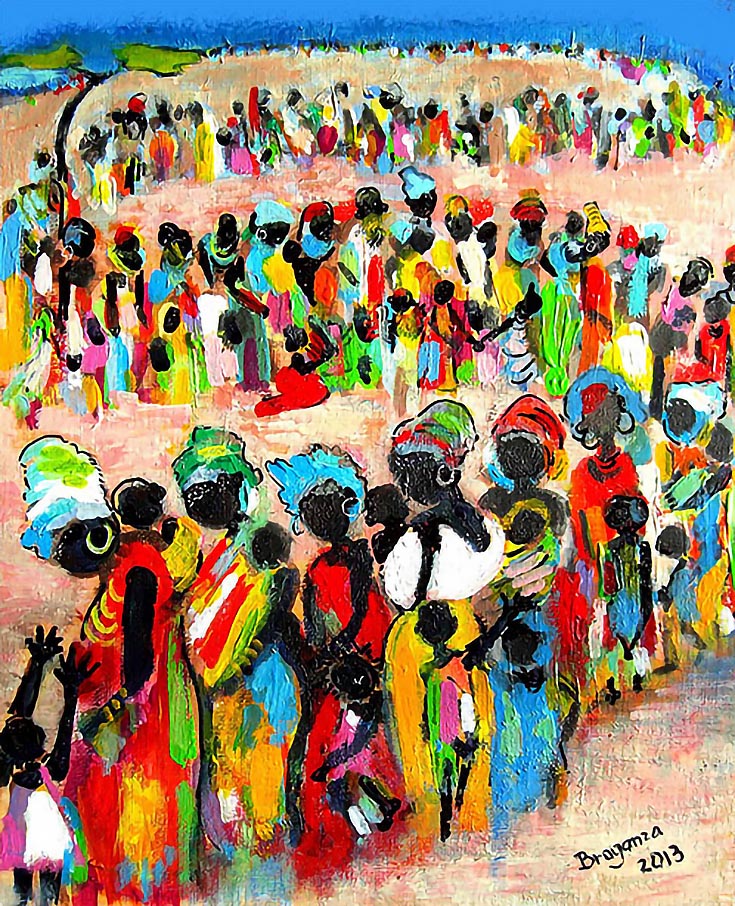“Human rights and the widespread denial of human rights is the most important subject in the world. At our peril, we close our eyes to human rights abuses.”
-David Fleming, President, International Federation of Human Rights Museums.

We live in delicate times. Global events often leave us feeling helpless, our hands tied. As an artist, I untied mine. Here is my story.
I was not always involved in human rights. . . In fact for the longest time, growing up, I didn’t even know what the words meant. As most people will confess, the concern for human rights evolves gradually, it doesn’t just happen overnight. There are triggers.
At the age of 7, living on the Indian sub-continent, I invited the 3 year old daughter of my jamadhar (sweeper) to cook with me on a mud stove, much to the horror of my parents.
I didn’t seem to mind her dirty, smelly rags, matted hair and runny nose. We fried onions in a battered degchi, threw in potatoes, chillies and curry leaves sniffing in the pungent aroma. Eating and licking our fingers, we laughed hilariously as the result tasted quite awful.
I then decided to wash her hair, dressed her in one of my white kurtas and sent her smugly back to her roadside hut. The next morning, the kurta was filthy and her hair knotted again. I was about to scream when she flashed me a contagious grin.
I will always remember her face and that moment in my life as my first lesson in human rights. Why did I want her to be like me? Did I think my life was better or happier than hers? These were questions that slipped in and out of my mind during the ensuing years.
After several years in Rome and London, I moved to Montreal, Canada in 1966. During this time I was able to express myself on canvas and my paintings mirrored my life, moving through the floral, the landscape, the abstract and the figurative.
Gradually, world issues began to consume me especially the plight of women and children. Reading about figures like Rosa Parks, Gandhi, Nelson Mandela, Martin Luther King, Aung San Suu Kyi, Thérèse Casgrain, Mother Theresa and how committed they were to their causes, I secretly wanted to be like them all!
In the midst of these musings came a sudden cancer diagnosis (multiple myeloma) and a mangled body which brought me face to face with my own mortality. In the hospital one day, an art therapist pushed a cart full of paint & brushes into my room, “I hear you’re an artist. Would you like to try to paint?” My first reaction was anger. . . can’t you see the mess I’m in? I can hardly move. I’ll never paint again.
She returned often—thankfully—until I finally relented. During my recovery year at home, I sat and painted in bed. Later with a cane in one hand I’d spend hours in front of my easel. Four seasons slithered by and some 50 paintings later, my cancer was in remission.
One summer evening in Montreal, I was handed a pamphlet by a white woman who was promoting a benefit supper in aid of the women of Afghanistan. “You’ve never been there. Why would you do this?” She looked me in the eye and simply said “Why not?”
That was the start of my activism. I realized then that something was unjust—the fact that women in many parts of the world were being denied their rights—so I painted the suffering and the hopes of these women, sharing my images with the Canadian Women for Women in Afghanistan, Rights and Democracy, Amnesty International, Global Fund for Women, the Canadian Grandmothers for Africa, Haitian Relief, and more.
I understood then that I didn’t need to go into the trenches, that I could still be a catalyst for change, still contribute with a paintbrush or a pen, in a hospital bed or at a Starbucks.
I also learned that by sharing my paintings with others, people would open up, expressing their opinions and criticisms, allowing us to enter into some kind of dialogue which is so crucial to understanding.
Some years ago, on CBC radio, Stephen Lewis spoke with compassion about his crusade to eliminate AIDS in Africa and about the grandmothers who take care of their orphaned grandchildren. I wrote to him and asked what I could do to help. Some weeks late at the Vancouver airport, I started a conversation with a stranger who casually mentioned that she was working for the Canadian Grandmothers campaign in my city. As a result, Journey of Hope (seen below) is now on their fundraising cards.
We are at the brink of a fragile 2016. With the explosion of social media, whether we like it or not, we are implicated, and involved.
I cry alone watching TV, overcome by the tragic events that surround us—the refugee crisis, the unrest in the Middle East, the horrific events in Paris, a city so beloved by artists.
I am saddened by my physical limitations, but I know that even caring a little means mountains more than not caring at all. Dabs of paint or doodles on a canvas are small gestures but miles better than staring at the ceiling, though that can be therapeutic too. Given a talent, I truly believe that we have a social and sacred obligation to use it wisely, as much for ourselves as for the greater good.
That’s one way to untie the shackles. I am doing it. Will you?
Cheryl Braganza is a Montreal artist, writer, and cancer survivor who collaborates with human rights organizations. Visit www.cherylbraganza.com to learn more.
This post may contain affiliate links.

